The Golden Age of Science Fiction: The 1973 Locus Award for Best Original Anthology: Again, Dangerous Visions, edited by Harlan Ellison (Also, a 1972 Special Award for Excellence in Anthologizing)
Again, Dangerous Visions (Doubleday, 1972)
Steven Silver has been doing a series covering the award winners from his age 12 year, and Steven has credited me for (indirectly) suggesting this, when I quoted Peter Graham’s statement “The Golden Age of Science Fiction” is 12, in the “comment section” to the entry on 1973 in Jo Walton’s wonderful book An Informal History of the Hugos. You see, I was 12 in 1972, so the awards for 1973 were the awards for my personal Golden Age. And Steven suggested that much as he is covering awards for 1980, I might cover awards for 1973 here in Black Gate.
1973 was the second year of the Locus “Original Anthology” award – in 1971, the first year of the Locus Awards, there was an award for Best Anthology/Collection (won by Robert Silverberg for The Science Fiction Hall of Fame Volume I), and in 1972 original anthologies got a separate category (won that year by Terry Carr’s Universe 1.) By 1972 the original anthology boom of the 1970s, fueled by Roger Elwood, was beginning to spike, and there were a lot of candidates, including Carr’s Universe 2, Silverberg’s New Dimensions II, two issues (10 and 11) of Damon Knight’s Orbit, entries from Robert Hoskins’ Infinity series, Harry Harrison’s Nova, Ted Carnell’s New Writings in SF, Michael Moorcock’s New Worlds Quarterly, and, indeed, Roger Elwood, with And Walk Now Gently Through the Fire. And many more. But I don’t think there was any doubt which anthology would win, for this was the year of Harlan Ellison’s Again, Dangerous Visions, the follow-on to the spectacularly successful 1967 book Dangerous Visions. (I should add that Ellison was also awarded a Worldcon Special Committee Award for “Excellence in Anthologizing” for this book, but that was, curiously, at the Worldcon the previous year, 1972, when A,DV had just appeared).)
Dangerous Visions (Berkley Medallion, 1972, cover by Vincent DiFate)
The Dangerous Visions anthologies were conceived as a venue for stories that traditional SF sources wouldn’t touch, due to controversial content. Sometimes the controversial aspect was experimental form, but more often it was political content, or sexual content. Or both, to be sure! It’s my feeling that much of the first book actually seemed dangerous when it appeared, but that by 1972 the “danger” had passed – the contents of Again, Dangerous Visions were just as politically and sexually provocative as Dangerous Visions, and some stories were probably even more experimental in form, but by then the battle had been won, and one was much more likely to see such content in the many other original anthologies that were appearing, and even in the magazines (though those were mostly still fairly conservative.) Mind you, some of the stories in Again, Dangerous Visions had been purchased around the time Dangerous Visions appeared – Ursula Le Guin, for one example, complained rather sharply about how long it took Ellison to get “The Word for World is Forest” into print. Richard Lupoff’s ambitious novel Space War Blues had to wait to be published for years to allow the related novella from Again, Dangerous Visions to appear first.
Still, if Again, Dangerous Visions was not as shocking as its predecessor, its quality remained exceptional. Stories from the first book took home two Hugos and two Nebulas – the second book’s stories won one each (Joanna Russ’ “When it Changed” took the Short Story Nebula, and Ursula K. Le Guin’s “The Word for World is Forest” took the Novella Hugo.) In addition to quality, A,DV had quantity: 47 short stories, plus of course Ellison’s famous introductions to each story, and author afterwords as well, for 830 pages in my SFBC edition. There are also interior illustrations, by the great Ed Emshwiller, who had mostly left off SF illustration by this time, to concentrate on his experimental film-making.
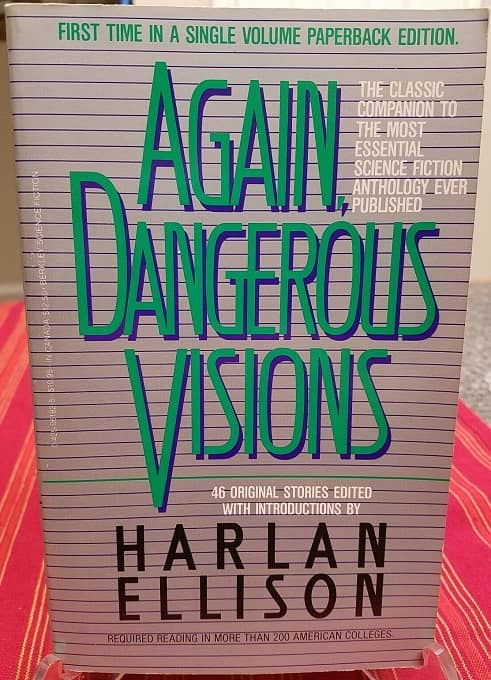 |
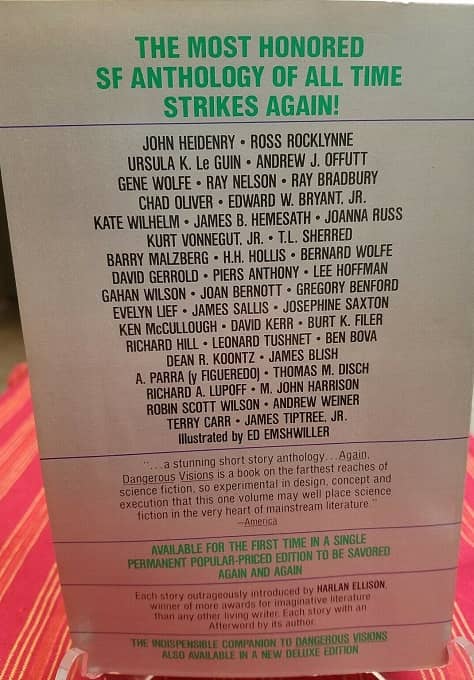 |
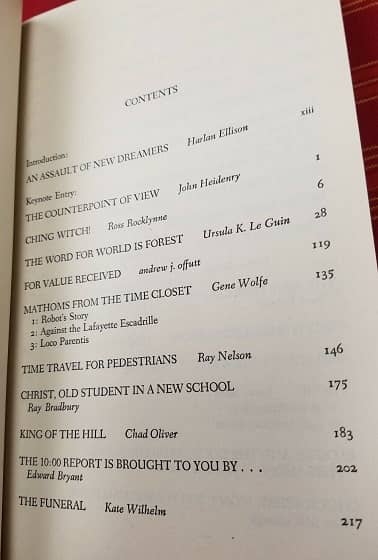 |
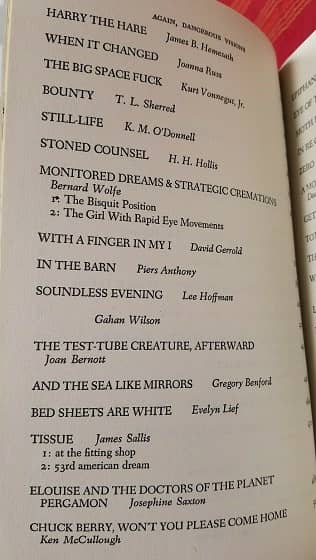 |
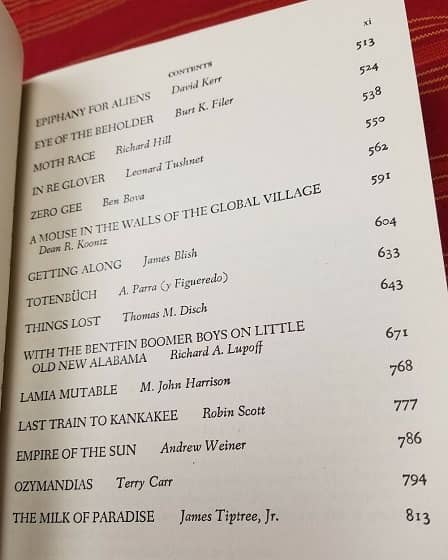 |
Ellison worked hard at assembling a wide mix of writers. He included a few writers mostly known in the mainstream: John Heidenry, Bernard Wolfe, Kurt Vonnegut, and A. Parra (y Figueredo). He included a couple of writers considered fairly old-fashioned by 1972: Ross Rocklynne, T. L. Sherred, and Chad Oliver. (The former two had all but stopped writing before Ellison coaxed stories from them.) He included well-established stars – older, such as James Blish and Ray Bradbury; and younger, such as Ursula K. Le Guin, Thomas M. Disch, Ben Bova, Joanna Russ, and Kate Wilhelm. He included newer writers who were clearly on the come, such as Gene Wolfe, David Gerrold, M. John Harrison, Terry Carr, Piers Anthony, Josephine Saxton, James Sallis, Gregory Benford, Edward Bryant, “K. M. O’Donnell” (Barry Malzberg), and James Tiptree, Jr. And he included some all but brand-new writers: Evelyn Lief, James Hemesath, Joan Bernott, Ken McCullough, Andrew Weiner.* He even included a piece mixing fiction and art by Gahan Wilson.
What were the best stories, then? Oddly, neither of the award winners were really among my favorites (though over time I’ve come to rate “When It Changed” much more highly than I did when I was 14.) My favorite in the book, then and now – and apparently Ellison’s favorite, too, based on its placement as the closing story – is James Tiptree, Jr.’s “The Milk of Paradise,” a stunning piece about a man utterly changed by his time on an alien planet – another one of her stories about exogamy. My other favorite back then was Richard A. Lupoff’s “With the Bentfin Boomer Boys on Little Old New Alabama.”** Other standouts were Kate Wilhelm’s “The Funeral,” M. John Harrison’s “Lamia Mutable,” and Thomas M. Disch’s “Things Lost.” I also liked the Weiner story, “With the Lafayette Escadrille” by Wolfe, and Gerrold’s “With a Finger in My Eye.”
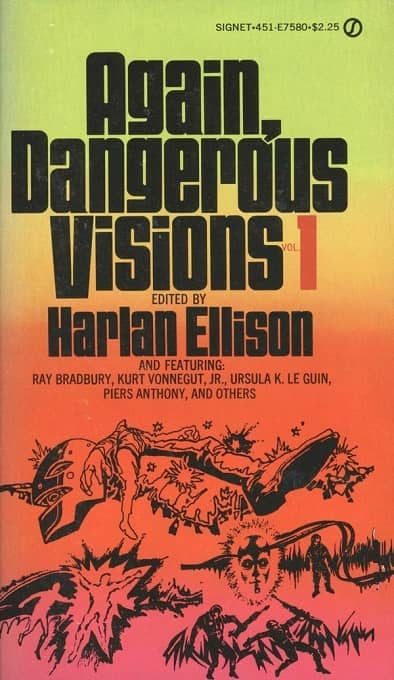 |
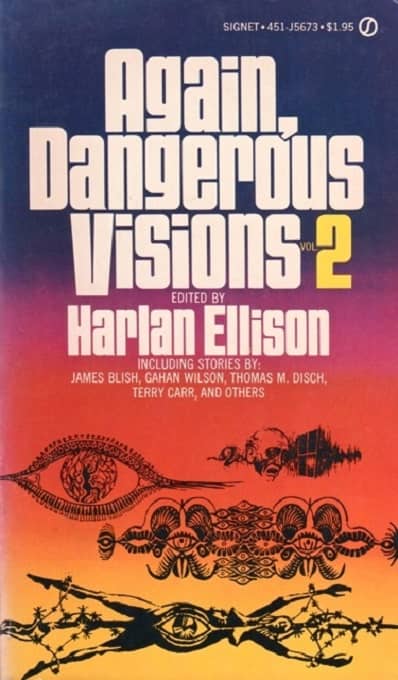 |
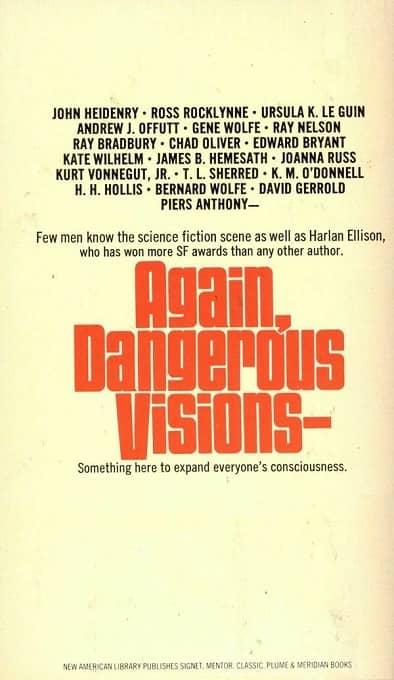 |
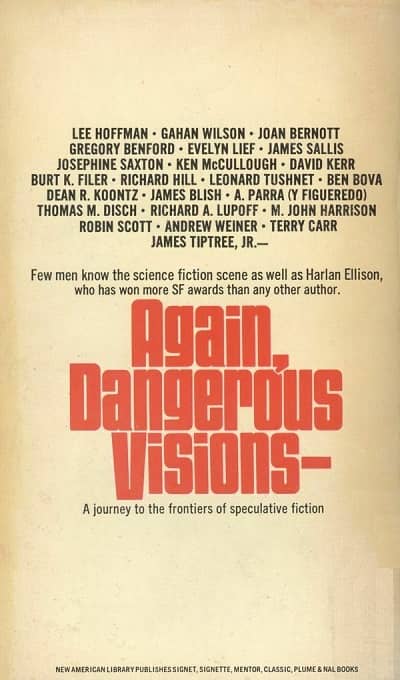 |
Again, Dangerous Visions (Signet / New American Library, 1977, covers by Ed Emshwiller)
Finally, one must mention a book Ellison mentioned in his introduction to this volume – the planned third of the trilogy, The Last Dangerous Visions. This was to be published (God willing, Ellison wrote) six months after Again, Dangerous Visions. As we all know, that didn’t happen. And over time, The Last Dangerous Visions, for which Ellison had bought perhaps 50 stories as of 1972, kept growing, both in volume and in legend, and Ellison died last year with the book still unpublished. Likely many of the stories would be hard to read at this remove. But it certainly would be interesting to see them! I wonder if anything of the sort will ever happen.
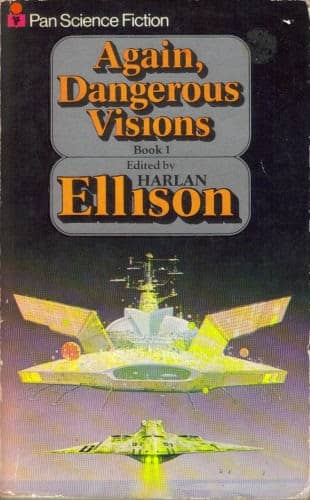 |
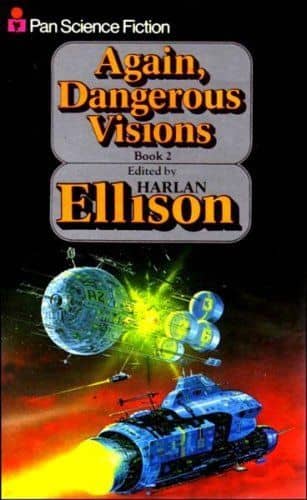 |
Again, Dangerous Visions (Pan, 1977, cover by Angus McKie)
(*Perhaps the most disappointing aspect of the book is that the truly “new” writers Ellison discovered almost all pretty much disappeared in fairly short order. Andrew Weiner did re-emerge some time later with some fairly strong work, including a couple novels and a fair quantity of pretty good short fiction.)
(**This is the one story to feature actual fairly explicit hot sex – other stories feature sex, such as Piers Anthony’s “In the Barn” and Tiptree’s great story, but the sex in those cases is fairly gross (well, very very gross in the Anthony.))
Rich Horton’s last article for us was a look at the 1973 Locus Award for Best Publisher: Ballantine Books. His website is Strange at Ecbatan. See all of Rich’s articles here.
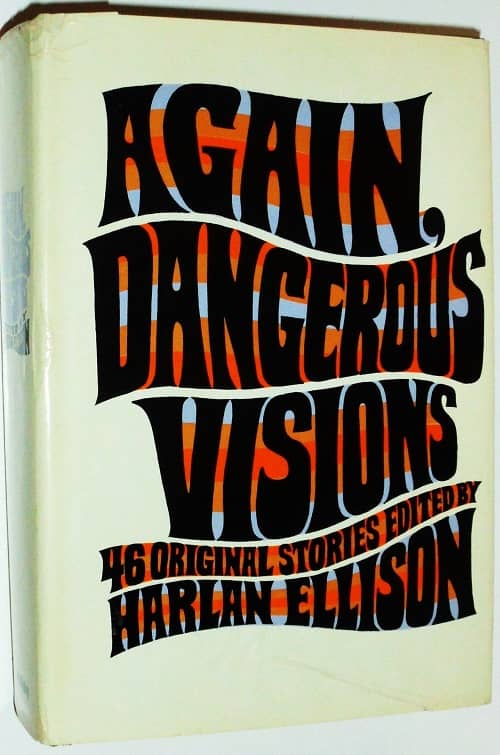
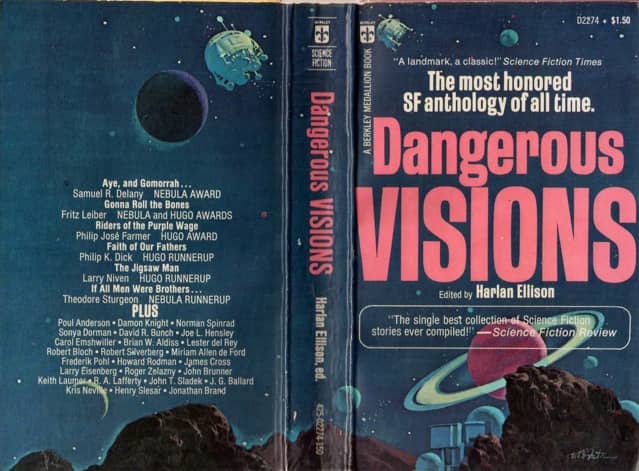
hey Rich (Steve Davidson, formerly the crotchety old fan, lol):
When ADV came out, it wasn’t my personal golden age, but close, but as a multi-year member of SFBC, I was offered this title and snapped it up.
Yes, you’re right, it wasn’t as Dangerous as DV had been, but it was still heady stuff for a teenager.
My favorite story of the bunch is Gahan Wilson’s ‘spot.
So far as LDV goes: I had occasion to try and get Harlan to let me look at one of the stories commissioned for it, at one point being told that he didn’t even know if he had the ms anymore; because the story was (is) needed to complete a project, I did a fair amount of research into it: I don’t have notes to work from, but the book itself changed publisher’s several times, one of whom sent an editor out to help “organize” things; she told me that the stories and other matter were present, but in a terrible state of non-organization; their existence has since been confirmed (though to me it looked like they were pretty well organized).
During our phone conversations and correspondence, I was VERY careful to never mention the name of that anthology, lol.
I miss Harlan.